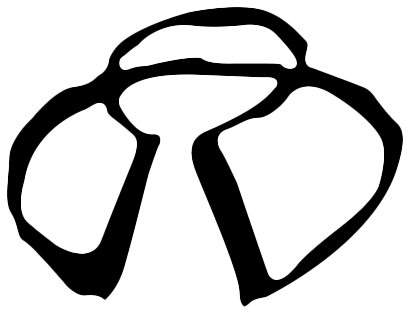Hector René Membreño-Canales 'New Orleans'
Drawer 4- New Orleans 1, Archival Pigment Print, 12x18, 2018
Artist Statement
The debate over Confederate monuments has many Americans reconsidering how historical figures are represented in public space. Monumental sculptures are often built 1/3rd larger than human scale, high upon a pedestal looking down at us, made of stone or bronze, rooted with bolts in to the ground. These materiel decisions support myth's of immortality, yet they're falling all around us. After-Ozymandias is a nod to a poem written by Percy Shelley about the inevitable decline of any empire and their surviving pretensions to greatness. Ozymandias is the Greek name for Pharaoh Ramesses II, who ruled Egypt during the thirteenth century. Percy wrote the poem in 1817 shortly after the announcement of the British Museum's acquisition of a large fragment of his statue. These photos are of what remains after a statue crumbles or falls; empty plinths.
Artist Bio
Hector René Membreño-Canales was born in San Pedro Sula, Honduras (1988) and grew up in Allentown, Pennsylvania. He's served more than a decade as a US Army Photographer with international posts including Iraq, El Salvador, Poland and more. He continues to work as an educator, photographer, and visual artist. After serving in Iraq Hector used the Post 9/11 G.I. Bill to study Photography at the School of Visual Arts (SVA) and earned his MFA from the Dept. of Art & Art History at Hunter College, The City University of New York. Hector’s work explores official histories, American patriotism, and the Military-Industrial Complex. His photographs have been exhibited at Osnova Gallery Moscow (2016), Aperture Foundation (2017), The Delaware Contemporary Museum of Art (2017), Field Projects (2018), and the Athens Institute of Contemporary Art (2019). His work has been featured and reviewed by The New York Times, The New Republic, The Columbia Journalism Review, NPR, CNN, and L’Oeil de la Photographie. Hector teaches Visual Studies and Photography in the Art Dept. at Phillips Academy, Andover.
Drawer 4- New Orleans 1, Archival Pigment Print, 12x18, 2018
Artist Statement
The debate over Confederate monuments has many Americans reconsidering how historical figures are represented in public space. Monumental sculptures are often built 1/3rd larger than human scale, high upon a pedestal looking down at us, made of stone or bronze, rooted with bolts in to the ground. These materiel decisions support myth's of immortality, yet they're falling all around us. After-Ozymandias is a nod to a poem written by Percy Shelley about the inevitable decline of any empire and their surviving pretensions to greatness. Ozymandias is the Greek name for Pharaoh Ramesses II, who ruled Egypt during the thirteenth century. Percy wrote the poem in 1817 shortly after the announcement of the British Museum's acquisition of a large fragment of his statue. These photos are of what remains after a statue crumbles or falls; empty plinths.
Artist Bio
Hector René Membreño-Canales was born in San Pedro Sula, Honduras (1988) and grew up in Allentown, Pennsylvania. He's served more than a decade as a US Army Photographer with international posts including Iraq, El Salvador, Poland and more. He continues to work as an educator, photographer, and visual artist. After serving in Iraq Hector used the Post 9/11 G.I. Bill to study Photography at the School of Visual Arts (SVA) and earned his MFA from the Dept. of Art & Art History at Hunter College, The City University of New York. Hector’s work explores official histories, American patriotism, and the Military-Industrial Complex. His photographs have been exhibited at Osnova Gallery Moscow (2016), Aperture Foundation (2017), The Delaware Contemporary Museum of Art (2017), Field Projects (2018), and the Athens Institute of Contemporary Art (2019). His work has been featured and reviewed by The New York Times, The New Republic, The Columbia Journalism Review, NPR, CNN, and L’Oeil de la Photographie. Hector teaches Visual Studies and Photography in the Art Dept. at Phillips Academy, Andover.
Drawer 4- New Orleans 1, Archival Pigment Print, 12x18, 2018
Artist Statement
The debate over Confederate monuments has many Americans reconsidering how historical figures are represented in public space. Monumental sculptures are often built 1/3rd larger than human scale, high upon a pedestal looking down at us, made of stone or bronze, rooted with bolts in to the ground. These materiel decisions support myth's of immortality, yet they're falling all around us. After-Ozymandias is a nod to a poem written by Percy Shelley about the inevitable decline of any empire and their surviving pretensions to greatness. Ozymandias is the Greek name for Pharaoh Ramesses II, who ruled Egypt during the thirteenth century. Percy wrote the poem in 1817 shortly after the announcement of the British Museum's acquisition of a large fragment of his statue. These photos are of what remains after a statue crumbles or falls; empty plinths.
Artist Bio
Hector René Membreño-Canales was born in San Pedro Sula, Honduras (1988) and grew up in Allentown, Pennsylvania. He's served more than a decade as a US Army Photographer with international posts including Iraq, El Salvador, Poland and more. He continues to work as an educator, photographer, and visual artist. After serving in Iraq Hector used the Post 9/11 G.I. Bill to study Photography at the School of Visual Arts (SVA) and earned his MFA from the Dept. of Art & Art History at Hunter College, The City University of New York. Hector’s work explores official histories, American patriotism, and the Military-Industrial Complex. His photographs have been exhibited at Osnova Gallery Moscow (2016), Aperture Foundation (2017), The Delaware Contemporary Museum of Art (2017), Field Projects (2018), and the Athens Institute of Contemporary Art (2019). His work has been featured and reviewed by The New York Times, The New Republic, The Columbia Journalism Review, NPR, CNN, and L’Oeil de la Photographie. Hector teaches Visual Studies and Photography in the Art Dept. at Phillips Academy, Andover.

